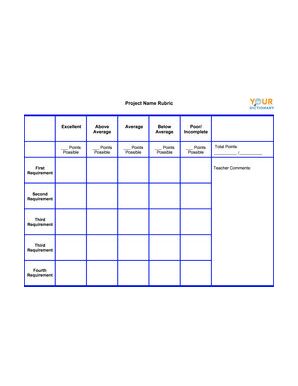

A rubric is a performance-based assessment tool. Teachers use rubrics to gather data about their students’ progress on a particular assignment or skill. Simple rubrics allow students to understand what is required in an assignment, how it will be graded, and how well they are progressing toward proficiency.
Rubrics can be both formative (ongoing) and summative (final) assessment tools for evaluating written work, projects, oral presentations, or any other class assignment. There are four types of rubrics: checklists, holistic rubrics, analytic rubrics, and developmental rubrics. Teachers, including homeschool parents, can refer to these simple rubric examples to formulate their own.
Rubrics as Checklists
These basic rubric examples ensure that all parts of the assignment are present. They help students keep track of each element of a project. Checklists also let teachers see whether a student fully participated in an assignment, but they aren’t as informative as other rubrics.
Example of a Checklist Rubric
Checklists are useful in all subject areas because they’re versatile and easy to understand. As long as each part of an assignment is present, the student receives full credit. An example of a science project checklist includes a column for students to check their work before turning it in.
|
Parts of a Cell Project Checklist |
Self Check |
Teacher Check |
|
Includes a cover page with name and project title |
||
|
Provides research notes from different sites |
||
|
Cell model is made of Play Doh, candy, or other material |
||
|
Cell model includes labels for each part of the cell |
||
|
Provides explanation paragraph for each part of the cell |
||
|
Total points |
Checklists are handy to use and easy to grade. They measure participation and completion of a project rather than skills achieved, unlike holistic rubrics.
Holistic Rubrics
A general rubric that lists a few levels of performance is a holistic rubric. These rubrics usually combine criteria for a certain score into one level. Holistic rubrics include more information than a checklist and make good formative assessment tools.
Example of a Holistic Rubric
The typical A-F grading system is one example of a holistic rubric in which many skills are combined for one score. Here is another example of a holistic rubric for an oral presentation in social studies.
|
Description |
Score |
|
The presenter spoke clearly, held eye contact throughout the presentation, used more than two visual aids (including multimedia), stood up straight without hands in pockets, answered questions, and spoke for more than 5 minutes. |
5 |
|
The presenter spoke clearly most of the time, looked down at notes but mostly held eye contact, used two visual aids (including multimedia), mostly stood up straight, answered one or two questions, and spoke for 4-5 minutes. |
4 |
|
The presenter spoke clearly for part of the time, mostly looked at notes but made eye contact a few times, used two visual aids (no multimedia), stood up straight for part of the time, answered one question, and spoke for 2-4 minutes. |
3 |
|
The presenter did not speak clearly, made eye contact a few times, used one visual aid (no multimedia), slouched or put hands in pockets a few times, did not answer questions, and spoke for 1-2 minutes |
2 |
|
The presenter was difficult to understand, did not look up from notes, did not have visual aids, slouched or put hands in pockets for most of the presentation, did not answer questions, and spoke less than 1 minute. |
1 |
|
The presenter did not prepare a presentation. |
0 |
|
Teacher comments: |
Although holistic rubrics are more complex than checklists, they aren’t as helpful for assessing specific skills within a project. It’s possible for students to score between two levels if they achieve some criteria but not others.
Analytic Rubrics
An analytic rubric assesses each aspect of an assignment. It awards a designated number of points to each part which adds up to the student’s final score. Projects with analytic rubrics take longer to grade, but they are informative to teachers as summative assessment tools.
Example of an Analytic Rubric
Analytic rubrics are useful in any subject in which the teacher needs to monitor discrete skills. Check out an example of an analytic essay for a language arts literary essay.
|
5 |
4 |
3 |
2 |
1 |
|
|
Comprehension of Text |
Shows a thorough and thoughtful understanding of the text. |
Shows a comprehensive understanding of the text. |
Shows a basic understanding of the text. |
Shows a limited understanding of the text. |
Shows little understanding of the text. |
|
Textual Evidence |
Includes at least 3 specific textual details that clearly support each topic sentence. Uses at least 2 sentences of commentary per concrete detail. |
Includes 3 specific textual details that generally support each topic sentence. Uses 2 sentences of commentary per concrete detail. |
Includes 2-3 general textual details in each body paragraph. Uses 1 or 2 sentences of commentary per concrete detail. |
Includes 1-2 general textual details in each body paragraph. Uses 1 sentence of commentary per concrete detail. |
Does not include textual details. |
|
Organization |
Essay is well-organized, including a strong intro, thesis statement that directly connects to three body paragraphs, and a thought-provoking conclusion. |
Essay is organized, and all necessary elements are present. The thesis is present but not well-supported. |
Essay is somewhat organized. Intro includes a weak thesis statement. Body paragraphs do not connect well to the thesis. |
Essay needs to be better organized. Thesis statement is hard to find. Includes fewer than three body paragraphs. |
Essay is one paragraph or does not have any appearance of organization. No thesis statement. |
|
Formal Voice |
Uses a variety of sentence types and precise, descriptive language to establish a formal voice. |
Uses a variety of sentence types and some descriptive language to establish a formal voice. |
Uses mostly simple and compound sentences. Includes some descriptive language. |
Uses mostly simple sentences with little to no descriptive language. |
Uses no sentence variety. Voice is not formal. |
|
Sentence Fluency & Grammar |
Contains 0-1 grammatical or syntax errors. |
Contains 2-3 grammatical or syntax errors. |
Contains 4-5 grammatical or syntax errors. |
Contains more than 6 grammatical or syntax errors. |
Contains serious grammatical or syntax errors. |
|
Format |
All formal specifications were followed (12-point font in Times New Roman, 1-inch margins, double spaced). |
One format specification was not followed (12-point font in Times New Roman, 1-inch margins, double spaced). |
Two format specifications were not followed (12-point font in Times New Roman, 1-inch margins, double spaced). |
Three or more format specifications were not followed (12-point font in Times New Roman, 1-inch margins, double spaced). |
Paper was not typed. |
|
Total Score |
|||||
|
Teacher Comments |
Analytic rubrics are an effective form of communication between teacher and student. Expectations are clear and results are easy to understand. However, if you want to measure a student’s progress over the long term, you’ll need a developmental rubric.
Developmental Rubrics
While other types of rubrics measure one assignment or project, a developmental rubric tracks a student’s overall progress toward proficiency. These continuum rubrics can span one standard, one subject, or one skill. Developmental rubrics are more time-consuming for teachers than analytic rubrics, but they are the most informative type of assessment tool.
Example of a Developmental Rubric
The Common Core standards are an example of a developmental rubric with benchmarks over each grade level. Standards-based grading systems are becoming more common in modern classrooms. Check out an example of a developmental rubric designed to keep track of elementary math skills in operations and algebraic thinking.
|
4 - Exceeding Standard |
3 - Proficient |
2 - Progressing |
1 - Not Meeting Standard |
|
|
Problem-Solving with Addition and Subtraction |
Student can use addition and subtraction to solve complex word problems. |
Student can use addition and subtraction to solve basic word problems. |
Student is learning to use addition and subtraction to solve word problems. |
Student struggles to use addition and subtraction to solve word problems. |
|
Add and Subtract within 20 |
Student can fluently add and subtract past 20 with a variety of strategies and has memorized all sums of one-digit numbers and some two-digit numbers. |
Student can add and subtract up to 20 with a variety of strategies and has memorized all sums of one-digit numbers. |
Student can add and subtract up to 20 with one strategy, and is learning additional strategies. They are working on memorizing sums of one-digit numbers. |
Student has difficulty adding and subtracting up to 20. They don’t have one-digit number sums memorized. |
|
Foundations for Multiplication |
Student can identify if a group of over 20 objects contains an odd or even number using a variety of strategies, and can explain their thought process. |
Student can identify if a group of 10-20 objects contains an odd or even number using a variety of strategies. |
Student knows the difference between odd and even numbers, and is learning how to identify whether a group of objects contains an odd or even number. |
Student doesn’t yet know the difference between odd and even numbers. |
Unlike other rubrics, developmental rubrics indicate an ongoing learning process. They measure skill rather than participation and effort levels. Students will ideally start at the Progressing level at the beginning of the unit or school year and will end at the Proficient level.
Making Your Own Rubric
No matter which type of rubric you use, there are several ways to ensure that it’s an effective learning tool. Here are some tips for creating a rubric:
- Be detailed. Students are more likely to meet requirements when they know exactly what you’re expecting.
- Provide rubrics at the very beginning of the project. No one likes surprises.
- No rubric can replace your own comments. While rubrics allow you to measure skills, students still need positive reinforcement about their work.
- Make rubric scores align directly with student grades. Parents and students can easily see why they lost a specific number of points.
- Use student-friendly language. Some academic language is helpful, but rubrics are just as valuable for students as they are for you.

If you’re ready to design your own rubric, start with the customizable rubric template we’ve provided here. You can add your own requirements, point system, and objectives. Happy grading!